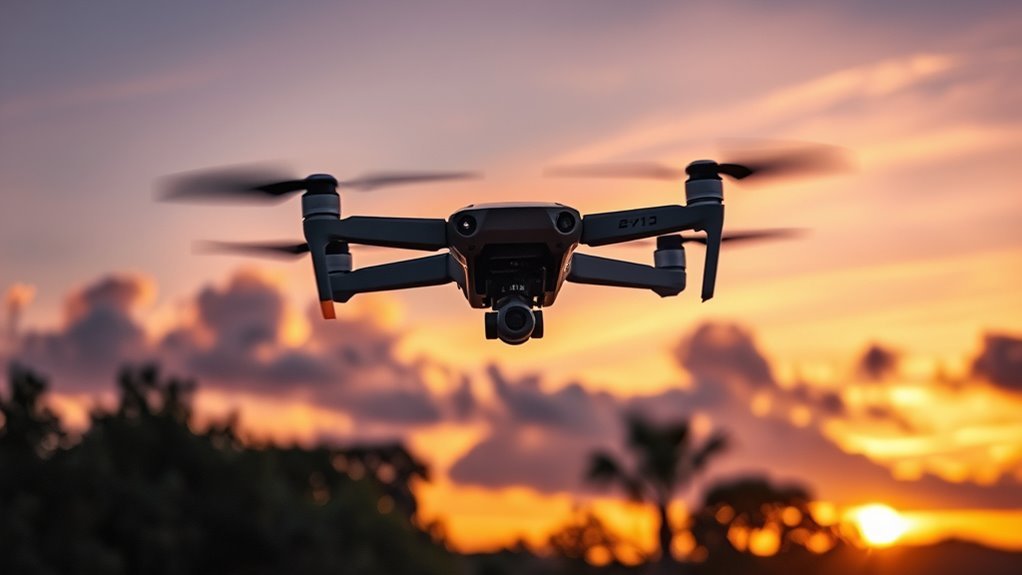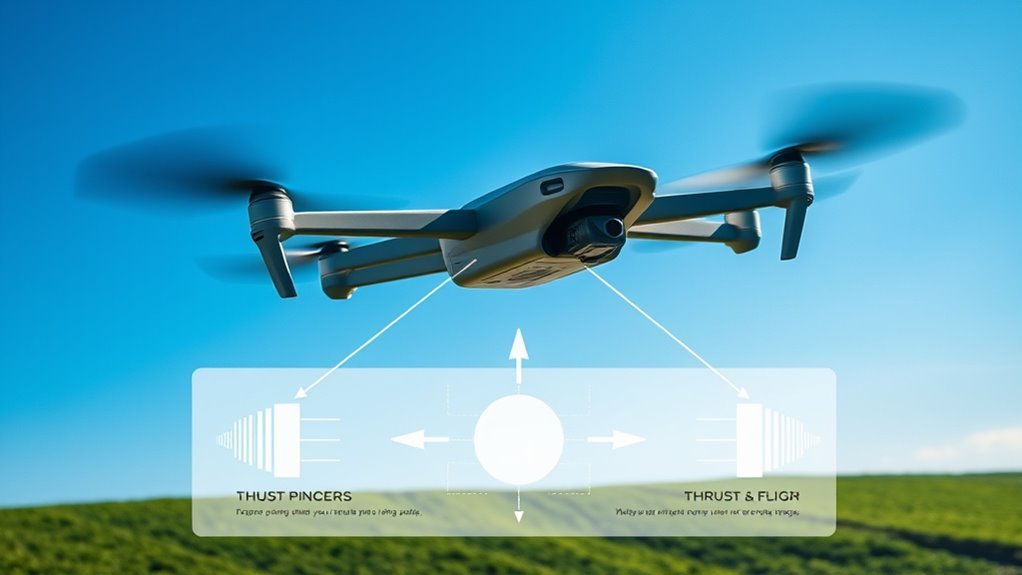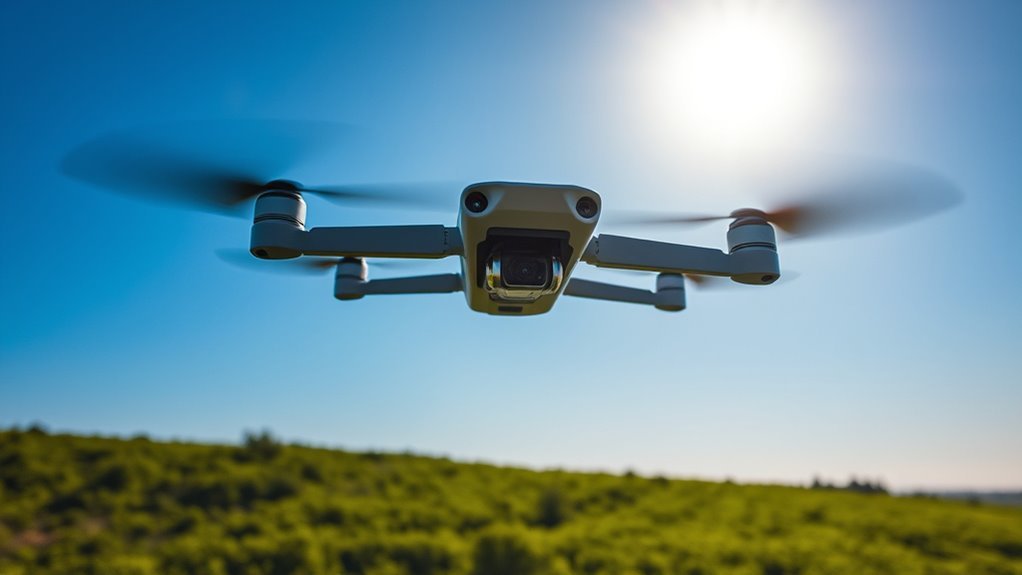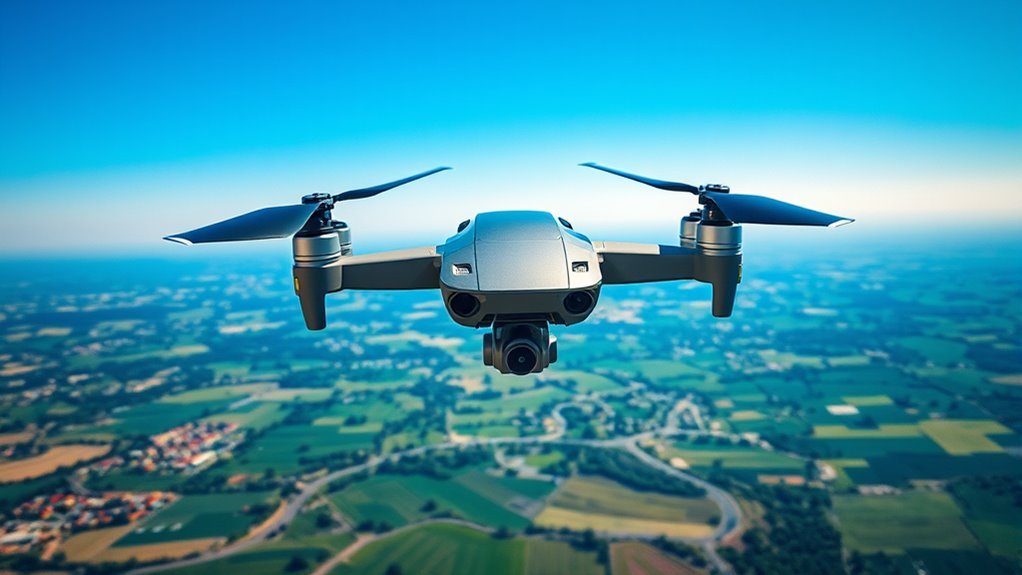To understand how drones fly, you should start with lift, which enables them to ascend through pressure differences created by rotors. Thrust, generated by propulsion systems like electric motors, propels the drone forward. Gravity plays a crucial role, requiring drones to produce enough lift to counteract it. Aerodynamics affects airflow and stability, while sensors and software help guide flight. Each component contributes to flight performance, and there’s much more to uncover about these fascinating machines.
The Basics of Flight: How Lift Works

Lift is the fundamental force that enables drones to ascend and remain airborne. Understanding lift generation is essential for anyone looking to harness the freedom of flight. Lift is primarily influenced by factors such as airspeed, wing shape, and angle of attack. When a drone’s rotors spin, they create a pressure difference between the upper and lower surfaces of the blades, resulting in upward force. This phenomenon, governed by Bernoulli’s principle and Newton’s third law, illustrates how lift factors interact to enable flight. By optimizing these factors, you can enhance lift efficiency, allowing your drone to navigate various environments with agility. Mastering these principles empowers you to explore the skies, experiencing the true essence of aerial freedom.
Understanding Thrust and Propulsion

To grasp how drones achieve flight, understanding thrust and propulsion is essential. You’ll need to explore the various propulsion systems available and the key factors that influence thrust generation. This knowledge will enhance your ability to analyze a drone’s performance and efficiency.
Types of Propulsion Systems
While understanding the various types of propulsion systems is crucial for grasping how drones achieve flight, it’s essential to recognize that these systems primarily generate thrust through different mechanisms. Electric propulsion, favored for its propulsion efficiency and quieter operation, uses batteries to power motors, allowing for precise lift generation. Gas propulsion, on the other hand, relies on internal combustion engines, often providing more power but with increased weight. Hybrid systems combine these approaches, utilizing both electric and gas engines, enhancing flexibility. Additionally, innovative rotor designs and thrust vectoring techniques can optimize flight dynamics. The exploration of alternative fuels is also gaining traction, promising to further reduce environmental impact while maintaining performance in diverse drone applications.
Factors Affecting Thrust
Understanding the factors that affect thrust is critical for maximizing drone performance, as they directly influence a drone’s ability to ascend and maneuver. Several key elements come into play in thrust optimization:
- Propeller Design: The shape and size can markedly affect airflow and thrust generation.
- Motor Efficiency: High-efficiency motors convert electrical energy to thrust more effectively, improving performance.
- Weight Distribution: Properly balancing the drone ensures ideal lift and stability.
- Environmental Factors: Conditions like altitude, wind speed, and temperature can alter air density, impacting thrust levels.
Being aware of these factors allows you to make informed adjustments, enhancing your drone’s flight capabilities and assuring it can navigate various environments with ease.
The Role of Gravity in Drone Flight

Gravity plays an essential role in drone flight by directly impacting lift generation. You must balance weight distribution to guarantee stability and control during flight. Understanding how gravity interacts with your drone’s design helps optimize performance and maneuverability.
Gravity’s Impact on Lift
Although many factors influence a drone’s ability to achieve flight, gravity remains a fundamental force that directly affects lift. Understanding how gravity impacts lift balance is vital for effective drone operation. Here are key points to take into account:
- Gravity effects: It pulls the drone downward, requiring sufficient lift to counteract it.
- Thrust generation: Drones must produce enough thrust to overcome gravitational pull.
- Weight considerations: Heavier drones need more lift, impacting battery life and flight duration.
- Altitude variations: As you ascend, gravity’s effect on lift changes, requiring adjustments in power output.
Balancing Weight Distribution
When it comes to drone flight, achieving ideal weight distribution is essential for stability and control. Proper load balancing guarantees that your drone responds accurately to your commands, allowing for smooth maneuvers and peak flight performance. If your drone’s weight is unevenly distributed, it can lead to unsteady flight patterns and difficulty in maintaining altitude.
To achieve balanced weight distribution, position heavier components, like batteries or cameras, centrally within the frame. This minimizes torque and enhances control, especially during turns. Regularly check your setup, as external factors like wind can affect load balancing. By prioritizing weight distribution, you’ll enhance your drone’s agility and responsiveness, granting you the freedom to explore the skies with confidence.
Aerodynamics: The Science of Airflow
Aerodynamics, the science of airflow, plays an essential role in understanding how drones achieve flight. By manipulating airflow patterns, drones can generate lift efficiently, allowing them to soar through the skies. Here are key factors influencing drone aerodynamics:
Aerodynamics is crucial for drones, enabling efficient lift generation and mastery of flight through airflow manipulation.
- Wing Shape: The design affects how air moves around the drone, influencing lift generation. Enhanced accuracy is achieved through high-resolution sensors that optimize flight dynamics.
- Angle of Attack: Adjusting this angle alters airflow patterns, enhancing or diminishing lift.
- Velocity: Higher speeds increase airflow, which can improve lift but may also lead to drag.
- Surface Area: Larger surfaces capture more air, contributing to lift generation but may add weight.
Additionally, the aerodynamic design of drones, such as the XG Neith, enhances stability and reduces air resistance, further optimizing flight performance. Understanding these elements empowers you to optimize drone performance and embrace the freedom of flight.
Components of a Drone: What Makes Them Fly
To understand how drones achieve flight, it’s essential to examine their core components. You’ll find that flight control systems, propulsion mechanisms, and sensor technology work together to create stable and efficient flight. Each component plays a pivotal role in ensuring the drone’s performance and responsiveness in various conditions. Additionally, automated flight modes enhance the user experience by simplifying operations and allowing for more focus on capturing dynamic footage. Furthermore, advanced stabilization techniques ensure smoother aerial shots, reducing the need for extensive post-production corrections.
Flight Control Systems
Although many people marvel at how drones take to the skies, understanding the underlying flight control systems reveals the technology that permits this capability. These systems consist of several key components that work together through sophisticated flight algorithms and control feedback mechanisms. Here’s what you need to know:
- Flight Controller: The brain of the drone, processing data and executing commands.
- Sensors: Devices like gyroscopes and accelerometers provide real-time data about the drone’s position and movement.
- GPS Module: Enables precise navigation and positioning.
- Communication System: Facilitates the exchange of commands and telemetry data between the drone and the pilot.
Together, these components guarantee stability, responsiveness, and control, allowing you to truly experience the freedom of flight.
Propulsion Mechanisms
While understanding flight control systems is essential, grasping the propulsion mechanisms of a drone is equally critical to its performance and efficiency. Drones typically rely on various propulsion types, including electric motors and gas engines, each offering distinct advantages. Electric motors are favored for their simplicity, low maintenance, and high engine efficiency, allowing for longer flight times. In contrast, gas engines provide greater power output, making them suitable for heavier drones. Understanding these propulsion types helps you optimize your drone’s capabilities based on your operational needs. The balance between weight, thrust, and fuel consumption directly impacts engine efficiency, ultimately determining how freely and effectively your drone can navigate its environment. Choose wisely for the best performance and freedom in flight.
Sensor Technology
Sensor technology plays a pivotal role in a drone’s ability to navigate and interact with its environment. The effectiveness of a drone largely hinges on various sensor types and their integration, enabling it to perform complex tasks autonomously. Here are four essential sensor types:
- GPS Sensors: Provide location data for precise navigation.
- IMUs (Inertial Measurement Units): Measure acceleration and angular velocity, informing stabilization.
- LiDAR Sensors: Create detailed 3D maps of the surroundings, enhancing obstacle detection.
- Cameras: Capture visual data for real-time feedback and reconnaissance.
The Importance of Stability and Control
Stability and control are critical for the safe and effective operation of drones, as they directly influence flight performance and maneuverability. When you fly a drone, understanding stability factors—such as weight distribution, center of gravity, and aerodynamic design—is essential. These elements determine how well your drone can resist disturbances and maintain a steady course. Control systems play an essential role in managing these stability factors, enabling you to execute precise movements and adjustments in real time. A robust control system interprets your commands and responds swiftly to environmental changes, ensuring smooth flight. By mastering stability and control, you can enhance your drone’s responsiveness and enjoy a more liberating flying experience, making the most of its capabilities. For instance, the Draganfly X4-ES employs multi-axis stabilization algorithms for quick adjustments, significantly improving its stability in turbulent conditions. Additionally, the aerodynamic design of the Draganfly X4-ES enhances airflow, further contributing to its flight stability and overall performance.
How Sensors and Software Guide Drones
As drones navigate complex environments, the integration of sensors and software becomes essential for ensuring accurate positioning and responsive control. This synergy allows drones to operate autonomously and effectively. Key components include:
- GPS Sensors: Provide location data for navigation.
- IMUs (Inertial Measurement Units): Measure acceleration and angular velocity for stabilization.
- Obstacle Detection Sensors: Identify and avoid obstacles in real-time, ensuring safer navigation through physical barriers.
- Software Algorithms: Process sensor data to execute flight commands and maintain stability.
Through advanced sensor integration, drones can adapt to varying conditions, enhancing their operational freedom. Software algorithms play a vital role in interpreting this data, enabling precise maneuvers and facilitating autonomous flight. Together, they empower drones to perform complex tasks while ensuring safety and efficiency. Notably, drones like the EXO Blackhawk 3 utilize advanced gyroscopes for improved stability, enhancing their performance in challenging flying conditions.
Battery Life and Energy Management
While you might think that a drone’s performance is solely dependent on its design and software, battery life and energy management are essential factors that greatly impact flight duration and operational efficiency. To maximize your drone’s capabilities, focus on energy efficiency through proper battery optimization techniques. Selecting high-capacity lithium-polymer (LiPo) batteries can enhance performance, but it’s also important to monitor discharge rates and maintain ideal charge levels. Implementing smart energy management systems allows for real-time monitoring of battery status, enabling you to make informed decisions during flight. Additionally, flight patterns can be adjusted to minimize energy consumption, extending your drone’s operational range. By prioritizing these factors, you can enjoy longer flights with improved reliability and performance. For instance, the DJI Mavic 3 Enterprise demonstrates how high-density lithium-polymer cells can optimize energy storage for extended flight times. Moreover, understanding battery endurance effects can help you choose the right drone for your needs, as seen in models like the Potensic Atom 2 with its superior battery life.
Types of Drones and Their Flight Mechanisms
Drones come in various types, each designed with unique flight mechanisms that cater to specific applications and environments. Understanding these types can enhance your flying experience:
- Recreational Drones – Often lightweight and user-friendly, perfect for beginners.
- Commercial Drones – Equipped for tasks like surveying and inspections, utilizing advanced sensors. Many commercial drones, such as the Lucid Sanitization Drone, are designed for specialized functions like sanitation.
- Military Drones – Feature sophisticated technology for surveillance and reconnaissance, emphasizing endurance and stealth.
- Racing Drones – Built for speed and agility, designed with lightweight frames for competitive flying.
Other categories include agricultural drones for crop monitoring and delivery drones for transport logistics, alongside photography drones that capture stunning aerial imagery and toy drones for casual fun. Each type’s flight mechanism reflects its intended use, maximizing efficiency and performance. Additionally, recent advancements in drone technology have led to improved battery life and range capabilities, allowing for longer flight times and greater operational efficiency.
Safety Considerations for Flying Drones
When operating a drone, prioritizing safety is essential to secure both compliance with regulations and the protection of people and property. Familiarize yourself with local drone regulations, as they outline where and when you can fly. Always conduct a pre-flight check to verify your drone is in good condition, and keep it in sight to avoid potential collisions. Establish emergency procedures, such as how to execute a controlled landing if you lose connection or experience a malfunction. Consider weather conditions, as strong winds can destabilize your flight. Additionally, understanding drone surveillance mechanisms is crucial for respecting the privacy of others and avoiding prohibited areas. Finally, understanding the typical lifespan of drones will help you manage maintenance and ensure safe operation. By following these guidelines, you can enjoy the freedom of flying while minimizing risks to yourself and those around you.
Frequently Asked Questions
How Do Weather Conditions Affect Drone Flight?
Weather conditions greatly affect drone flight. Temperature effects can alter battery performance, while humidity impact may reduce sensor efficiency. You must monitor these factors to guarantee ideal drone operation and maintain your freedom in the skies.
Can Drones Fly in High Winds?
When winds roar like wild stallions, drones struggle against wind resistance, risking stability. In high winds, their flight can become erratic, compromising control and safety. So, it’s best to keep them grounded during such conditions.
What Are the Legal Restrictions for Flying Drones?
When flying drones, you need to be aware of drone regulations and airspace restrictions. Always check local laws to guarantee compliance, as violations could lead to fines or operational limitations that impact your flying freedom.
How Can I Maintain My Drone for Optimal Performance?
Maintaining your drone’s performance is like tuning a finely crafted instrument. Regularly check the drone battery, ensuring it’s charged and undamaged. Don’t forget propeller maintenance; clean and replace them as needed for peak flight efficiency.
What Should I Do if My Drone Loses Connection?
If your drone loses connection, first try reconnection techniques like toggling the controller or restarting both devices. If that fails, follow emergency procedures to safely land or retrieve your drone, minimizing risk to yourself and others.

